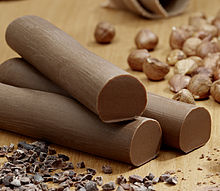Gianduja (chocolate)
 Gianduja bars | |
| Type | Chocolate |
|---|---|
| Place of origin | Italy |
| Region or state | Turin, Piedmont |
| Main ingredients | Chocolate paste, hazelnut paste |
Gianduja or gianduia[a] is a homogeneous blend of chocolate with 30% hazelnut paste, invented in Turin during Napoleon's regency (1796–1814). It can be consumed in the form of bars or as a filling for chocolates.
Gianduja is chocolate stretched with hazelnut butter. Similarly to standard chocolate, it is made in both plain and milk versions. It may also contain other nuts, such as almond.[2] As a bar, gianduja resembles normal chocolate, except for the fact that it is significantly softer due to the presence of hazelnut oil,[3] which is liquid at room temperature unlike cocoa butter. However, like conventional chocolate, gianduja is usually tempered.[4]
Chocolate hazelnut spreads are also notably inspired from gianduja. They tend to use, however, other ingredients, typically cocoa powder and vegetable oils rather than cocoa butter-based chocolate.
History
[edit]The Continental System, imposed by Napoleon in 1806, prevented British goods from entering European ports under French control, putting a strain on cocoa supplies.[5] A chocolatier in Turin named Michele Prochet extended the little chocolate he had by mixing it with hazelnuts from the Langhe hills south of Turin.[6] It is unclear when gianduja bars were made for the first time. However, Kohler is generally credited for the addition of (whole) hazelnuts to chocolate bars in 1830.[7] It is also known that, in 1852, Turin-based chocolate manufacturer Caffarel invented gianduiotto, which is a small ingot-shaped gianduja.[8]
It takes its name from Gianduja, a Carnival and marionette character who represents the archetypal Piedmontese, natives of the Italian region where hazelnut confectionery is common.
See also
[edit]![]() Media related to Gianduia at Wikimedia Commons
Media related to Gianduia at Wikimedia Commons
- List of Italian desserts and pastries
- Cremino – a gianduja specialty
- Nutella – which was originally called Pasta Gianduja[9]
- Gianduiotto
- Gianduja
Notes
[edit]- ^ Pronounced /dʒænˈduːjə/ jan-DOO-yə, UK also /dʒænˈduːdʒə/ jan-DOO-jə, US also /dʒɑːnˈduːjə/ jahn-DOO-yə; Italian: [dʒanˈduːja];[1] Piedmontese: giandoja [dʒaŋˈdʊja].
References
[edit]- ^ "Focus on Gianduia, Part 1.5: Orthography and Pronunciation – DallasFood". dallasfood.org.
- ^ Beckett, Steve T. (2011). "Gianduja chocolate". Industrial Chocolate Manufacture and Use. John Wiley & Sons. ISBN 9781444357554.
- ^ Medrich, Alice (2015). Pure Dessert: True Flavors, Inspiring Ingredients, and Simple Recipes. Artisan Books. p. 157. ISBN 9781579656850.
gianduja resembles a bar of chocolate. It is softer on the tooth than a plain chocolate bar (because of the oil from the hazelnuts)
- ^ Laiskonis, Michael (16 March 2021). "Going Nuts for Gianduja". Institute of Culinary Education. Retrieved 18 March 2024.
- ^ Elena Kostioukovitch (2009) Why Italians Love to Talk About Food p.95, Farrar, Straus and Giroux, ISBN 978-0374289942
- ^ ""Turin's chocolatiers" (Feb 2013) Gourmet Traveller Magazine". Archived from the original on 2020-04-11. Retrieved 2014-05-26.
- ^ Hermé, Pierre (2019). Le Larousse du chocolat. Editions Larousse. p. 44. ISBN 9782035981820.
Les noisettes furent les premiers fruits à être ajoutés dans le chocolat solide, une innovation suisse due à Kohler en 1830.
[Hazelnuts were the first fruits to be added to solid chocolate, a Swiss innovation due to Kohler in 1830.] - ^ "Caffarel – Finest Chocolate and the Best Hazelnuts". Caffarel.
- ^ The History of Nutella Archived 2015-09-12 at the Wayback Machine
